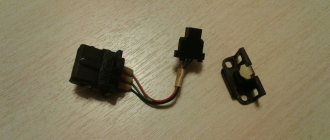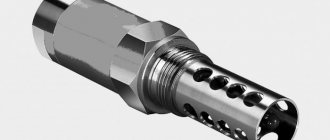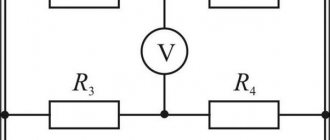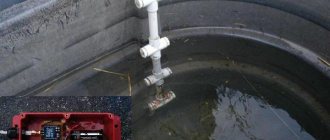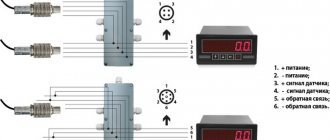Temperature control is ubiquitous in technological processes, allowing you to select the appropriate operating mode or monitor changes in the state of the material. Temperature conditions are equally important when turning on the oven in the kitchen, as well as in blast furnaces when melting steel, and deviation from normal operation can lead to an accident and injury to people. To avoid unpleasant consequences and ensure the ability to regulate the degree of heating, a temperature sensor is used.
Thermoelectric temperature sensors (thermocouples)
The operating principle of this group of sensors is based on the fact that an electric current arises in closed circuits of conductors or semiconductors if the soldering points differ in temperature. To measure temperature, one end of the thermocouple is placed in the measuring medium, and the other is used to read the values. The only significant drawback of this type of meters is their rather large error, which is unacceptable for many technological processes.
An example of such a sensor is the TSP Metran-246 sensor, which is designed to measure the temperature of solids.
It is used in metalworking and serves to control the temperature of bearings. The measurement range is from -50 to +120 degrees Celsius, the output signal for reading is analog.
Watch a video about temperature sensors below:
Application
The scope of application of temperature sensors covers both household appliances and equipment for general industrial use, the agricultural industry, the military industry, and the aerospace sector. Each of you can find them at home in heating appliances - boilers, ovens, multicookers or bread makers.
In heavy industry, thermal sensors make it possible to control the degree of heating of furnaces, air in the working area, and the condition of rubbing surfaces. In medicine, they are used to control temperature in hard-to-reach places or to simplify various procedures.
Many car enthusiasts often come across temperature analyzers that monitor the condition of oil or other coolant. On the railway network, they make it possible to monitor the heating of axle boxes and wheel sets. In the energy sector, they are used to examine contact connections and the quality of surface contact.
Thermistor sensors
As the name suggests, this type of sensor works on the principle that the resistance of a conductor changes as its temperature changes. Due to their simple and reliable design, sensors of this type are widely used in electronics and mechanical engineering. The undeniable advantage of these meters is their high accuracy, sensitivity and simple reading devices.
An example of a thermistor sensor is model 700-101BAA-B00, which has an initial resistance of 100 Ohms and a measurement range from -70 C° to +500 C°.
It is made using a platinum plate and nickel contacts. Widely used in electronics and industrial machines.
How to choose?
When choosing a temperature sensor, you must be guided by the following criteria:
- if the sensor is in contact with or located inside the measured medium, then a contact model is taken, if it is located outside the object, then a non-contact model;
- the conditions and state of the environment in which it will operate (humidity, aggressive substances, etc.) must correspond to the capabilities of the sensor;
- the step and calibration of measurements should ensure convenient operation of both the sensor and the equipment;
- if the sensor must be replaced during operation, then replacement options are installed;
- when choosing a temperature sensor to replace a faulty one, it is better to use its VIN code;
- The operating temperature limit must cover all possible heating values, some of which are shown in the table below.
Table: temperature limits of thermoelectric type sensors
| Type | Compound | Temperature range |
| T | copper/constantan | -250 °C to 400 °C |
| J | iron/constantan | -180°C to 750°C |
| E | chromel/constantan | -40 °C to 900 °C |
| K | chromel / alumel | -180 °C to 1,200 °C |
| S | platinum-rhodium (10%) / platinum | from 0 °C to 1,700 °C |
| R | platinum-rhodium (13%) / platinum | from 0 °C to 1,700 °C |
| B | platinum-rhodium (30%) / platinum-rhodium (6%) | from 0 °C to 1,800 °C |
| N | nichrosil / nisil | -270 °C to 1,280 °C |
| G | tungsten / rhenium (26%) | from 0 °C to 2,600 °C |
| C | tungsten-rhenium (5%) / tungsten-rhenium (26%) | from 20 °C to 2,300 °C |
| D | tungsten-rhenium (3%) / tungsten-rhenium (25%) | from 0 °C to 2,600 °C |
Semiconductor thermal sensors
This type of sensor works on the principle of changing the characteristics of a pn junction under the influence of temperature. Since the dependence of the voltage on the transistor on temperature is always proportional, it is possible to make a sensor with high measurement accuracy. The undoubted advantages of this solution are low cost, high data accuracy, and linearity of characteristics over the entire measurement range. In addition, they can be mounted directly on a semiconductor substrate, which makes this type of sensor indispensable for the microelectronics industry.
An example of such a device would be the LM75A sensor . Temperature range - from -55 C° to +150 C° , measurement error - ±2 C°. The measurement step is only 0.125 C°. supply voltage is from 2.5 to 5.5 V, and signal conversion time is up to 0.1 second.
Connection diagrams
The main differences in connecting a temperature sensor are determined by its scope of application and design features. So, within the framework of the article, we will look at several of the most common and interesting options. These are connections using a two-wire and three-wire circuit.
Rice. 5. Two-wire connection diagram
Figure 5 shows an option for two-wire connection of a measuring device. This principle is recommended for all temperature sensors with a short distance to the monitored object. Since the resistance of the most sensitive element Rt will change little from the resistance of the connecting conductors R1 and R2, accordingly, the correction for measurements will be minimal.
Rice. 6. Three-wire connection diagram
At long distances, from 150 m or more, the sensor should be connected using a three-wire circuit, which significantly reduces the error in resistance in wires R1, R2, R3.
Rice. 7. Connection diagram for engine temperature sensor
In almost every modern car, the temperature parameters of the engine are constantly monitored. Therefore, the use of a sensor is a mandatory safety requirement. According to the two-wire diagram (Figure 7), the sensor is connected with one terminal to a separate hood end switch, which does not have any connections to the circuit. And the second output is connected to the alarm unit in the established order, in accordance with the model.
Rice. 8. Connection diagram for digital temperature sensor
Figure 8 shows an example of enabling the Dallas digital sensor. This is a model with three pins, the first of which, according to the GND pinout, is connected to the ground pin of the microcontroller, the second DATA to the PIN 2 pin, and the third to the +5 V power terminal. A 4.7 kOhm resistor is connected between the third and second pins.
Pyrometers (thermal imagers)
A non-contact type of thermal sensors that read radiation that comes from heated bodies. This type of device allows you to measure temperature remotely, without getting close to the environment in which the measurements are taken. This allows you to work with high temperatures and very hot objects without dangerous proximity.
All pyrometers, based on their operating principle, are divided into interferometric, fluorescent, and sensors based on solutions that change color depending on temperature.
Types, device and principle of operation
With the development and improvement of technology, the temperature sensor, as a measuring device, has undergone numerous changes and upgrades. Thanks to this, today they are presented in a wide variety, which can be divided according to several criteria. Thus, depending on the method of transmitting and displaying temperature measurement data, they are divided into digital and analog. Digital devices are a more modern solution, since the information in them is displayed on a display and transmitted via electronic communication channels; analog devices have a dial display of data, an electrical or mechanical method of transmitting measurements.
Depending on the operating principle, all sensors can be divided into:
- thermoelectric;
- semiconductor;
- pyrometric;
- thermoresistive;
- acoustic;
- piezoelectric.
Thermoelectric
The operation of a thermoelectric sensor is based on the principle of a thermocouple (see Figure 1) - all metals have a certain valency (the number of free electrons in external atomic orbits that are not involved in rigid bonds). When exposed to external factors that impart additional energy to free electrons, they can leave the atom, creating the movement of charged particles. In the case of combining two metals with different electron release potentials and subsequent heating of the junction, a potential difference will arise, called the Seebeck effect.
Rice. 1. Thermocouple device
In practice, several types of thermoelectric temperature sensors are used, so, according to clause 1.1 of GOST R 50342-92, they are divided into:
- tungsten-tungsten rhenium (TVR) – used in environments with high operating temperatures of the order of 2000°C;
- platinum-rhodium-platinum-rhodium (TPR) - characterized by high cost and high measurement accuracy, they are used in laboratory measurements;
- platinum-rhodium-platinum (TPP) - equipped with a protective metal tube and ceramic insulation, have a high temperature limit;
- chromel-alumel (TCA) - widely used in industry, capable of covering a temperature range of up to 1200°C, used in acidic environments;
- chromel-copel (TCC) - characterized by an average temperature indicator, mounted only in non-aggressive environments;
- chromel-constantan (TCC) - relevant for gas mixtures and liquefied aerosols of neutral or slightly acidic composition;
- nikrosil-nisil (TNN) - used for devices in the medium temperature range, but have a long service life;
- copper-constantan (TMK) – characterized by the smallest measurement limit up to 400°C, but is resistant to moisture and some categories of aggressive environments;
- iron-constantan (TC) - used in an environment with a liquefied atmosphere or vacuum space.
Such a variety of thermocouple-based temperature sensors makes it possible to cover any area of human activity.
Semiconductor
They are made on the basis of crystals with a given current-voltage characteristic. Such temperature sensors operate in semiconductor switch mode, similar to a classic bipolar transistor, where the degree of heating is comparable to the application of potential to the base. As the temperature rises, the semiconductor sensor will begin to produce more current. As a rule, the semiconductor itself is not used to measure heating, but is connected through an amplifier circuit (see Figure 2).
Rice. 2. Connecting a semiconductor sensor via an amplifier
They are distinguished by a wide range of measurements and the ability to adjust the sensor in accordance with the operating parameters of the equipment. They are a high-precision type, little dependent on the duration of operation. They have small dimensions, due to which they are easily installed in circuits, radio elements, etc.
Pyrometric
They work using special sensors - pyrometers, which allow you to detect the slightest temperature fluctuations on the working surface of any object. The sensitive element itself is a matrix that responds to a certain frequency in the temperature range. This principle is the basis for measurements with a non-contact thermometer, which became widespread during the fight against coronavirus. In addition, their use is actively used for thermal imaging monitoring of structural elements, equipment, buildings and structures.
Rice. 3. Operating principle of the pyrometric sensor
Thermoresistive
Such temperature sensors are made on the basis of thermistors - devices with a certain dependence of resistance on the degree of heating of the base material. As the temperature rises, the conductivity of the resistor also changes, so you can monitor the condition of the desired object.
The main disadvantage of a thermistor sensor is the small range of measured temperature, but it is capable of providing a good measurement step and high accuracy in tenths and hundredths of degrees Celsius. Because of this, they are often included in a circuit using an amplifier that expands the operating limits.
Acoustic
Acoustic temperature sensors operate on the principle of determining the speed of sound vibrations depending on the temperature of the material or surface. The sensor itself directly compares the speed of sound generated by the source, which will differ depending on the degree of heating (see Figure 4). This type is non-contact and allows measurements to be taken in hard-to-reach places or at high-risk sites.
Rice. 4. Sound temperature sensor
Piezoelectric
The operation of the sensor is based on the effect of propagation of vibrations of a quartz crystal during the passage of electric current. But, depending on the ambient temperature, the oscillation frequency of the crystal will also change. The principle of recording temperature changes is to measure the frequency of oscillations and subsequent comparison with the established calibration of ratings for different temperatures.
Piezoelectric temperature sensors
All sensors of this type operate using a quartz piezoresonator. The whole essence of the work is the direct piezoelectric effect, that is, a change in the linear dimensions of the piezoelectric element under the influence of electric current. When a different-phase current with a certain frequency is alternately supplied, the piezoresonator oscillates, and the frequency of its oscillations depends on the temperature. Knowing this dependence, you can easily convert data on the resonator oscillation frequency into temperature.
Another video about the types of temperature sensors:
Due to their wide measurement range and high accuracy, such sensors are used mainly in research and experiments where high reliability and durability are required.
Main types of humidity sensors
Capacitive - uses the effect of changing capacitance depending on the humidity of the environment. Such sensors are capacitors with air as a dielectric.
Resistive - these sensors are based on changes in resistance depending on humidity. In essence, these are ordinary resistors with variable resistance. Resistive sensors measure the amount of current flowing and are inexpensive.
Optical is the most accurate type of device, based on such a physical concept as the “dew point”. The basic operating principle is based on measuring light intensity using a photoresistor. An LED is used as a light source.
Bimetallic thermal relays
In such relays, operation occurs due to the bending of a platinum or disk made of bimetal (that is, two metals), due to different volumetric expansion of dissimilar metals. They are quite simple and trouble-free
There are two varieties of these types of relays - thermostats and temperature limiters. The first type regulates the temperature within certain limits, automatically turning the load on and off, while the second type is used for protection and requires a special reset button after triggering.
Industrial temperature sensors and sensors
In addition to standard household temperature sensors, there are industrial ones, which are used exclusively at special facilities. Their distribution is aimed at a specific group of people due to the excess capabilities that are required only in production. Some are capable of operating in a variety of non-traditional environments and harsh conditions. The selection of suitable types is carried out in the same way as for the selection of household sensors.
Types of devices for taking temperature
Thermal devices can be classified according to a number of important criteria, including the method of transmitting information, the location and conditions of installation, as well as the algorithm for taking readings.
By method of information transmission
According to the method of transmitting information used, sensors are divided into two large categories:
- wired devices;
- wireless sensors.
Initially, all such devices were equipped with wires through which thermal sensors communicated with the control unit, transmitting information to it. Although such devices have now replaced their wireless counterparts, they are still often used in simple circuits.
In addition, wired sensors are more accurate and reliable in operation.
To ensure consistent operation of a wired sensor used in a composite device, it is advisable to combine it with equipment that is made by the same manufacturer
Currently, wireless devices have become widespread, which most often transmit information using a radio wave transmitter and receiver. Such devices can be installed almost anywhere, including a separate room or open air.
Important characteristics of such temperature sensors are:
- presence of battery;
- error of measurements;
- signal transmission range.
Wireless/wired devices can completely replace each other, but there are some peculiarities in their functioning.
By location and method of placement
Based on the mounting location, such devices are divided into the following types:
- overheads attached to the heating circuit;
- submersible, in contact with the coolant;
- indoor, located inside a residential or office space;
- external, which are located outside.
Some units may use several types of sensors simultaneously to control temperature.
According to the mechanism for taking readings
According to the method of displaying information, devices can be:
- bimetallic;
- alcohol.
The first option involves the use of two plates made of different metals, as well as a dial indicator. As the temperature rises, one of the elements is deformed, creating pressure on the arrow. The readings of such devices are characterized by good accuracy, but their big disadvantage is their inertia.
Bimetallic and alcohol thermostats are often installed on heating equipment, such as boilers. They allow you to monitor heat, exceeding which can lead to fatal consequences.
Sensors whose operation is based on the use of alcohol are almost completely free from this drawback. In this case, an alcohol-containing solution is poured into a hermetically sealed flask, which expands when heated. The design is quite elementary, reliable, but not very convenient for observations.
Where can I buy
Various sensors can always be purchased at a nearby specialty store. But there is another option that has recently received significant improvements. You no longer need to wait a long time for a parcel from China: the AliExpress online store now offers the opportunity to ship from transshipment warehouses located in various countries. For example, when ordering, you can specify the “Delivery from the Russian Federation” option.
Follow the links and choose:
| Temperature and humidity sensor Camason, Tuya | Geevon Wireless Weather Station | Aqara Zigbee temperature and humidity sensor |
| Automotive exhaust temperature sensor | Digital Infrared Thermometer - 50~600C | Temperature sensor DS18B20 for Arduino |
Do-it-yourself installation recommendations
Such devices are widely used for various purposes: they are equipped with radiators, heating boilers and other household appliances.
Before starting installation, you should carefully read the instructions: it indicates not only the installation features (for example, dimensions for connecting to the pipe), but also the operating rules, as well as the temperature limits for which the measuring device is suitable.
It is also necessary to take into account the size of the sleeve, which can vary between 120-160 mm.
Let's consider the two most common cases of installing a temperature sensor.
Connecting the device to a radiator
It is not necessary to equip all heating devices with a thermostat. According to the regulations, sensors are installed on the battery if its total power exceeds 50% of the heat generated by similar systems. If there are two heaters in the room, then the thermostat is installed only on one, which has a higher power rating.
The temperature sensor is a mandatory component of temperature controllers that allow you to reduce or increase the heating of radiators, heated floors and other heating devices
The device valve is installed on the supply pipeline at the point where the radiator is connected to the heating network. If it is impossible to insert it into an existing chain, the supply line must be dismantled, which can cause some difficulties.
To carry out this manipulation, you need to use a tool for cutting pipes, while installing a thermal head can be easily done without special equipment. As soon as the sensor is mounted, it is enough to align the marks made on the body and the device, after which the head is fixed with a smooth hand press.
Installation of air temperature sensor
Such a device is installed in the coldest living room without drafts (in the hall, kitchen or boiler room its installation is undesirable, as it can cause disruptions in the operation of the system).
When choosing a location, you need to make sure that the device is not exposed to sunlight, and there should be no heating devices (heaters, radiators, pipes) nearby.
For a conventional heating system, one thermostat is sufficient, while with a collector circuit it is advisable to use several sensors, the number of which coincides with the number of rooms. This will allow you to individually regulate the temperature in separate spaces.
The device is connected according to the instructions contained in the technical data sheet, using the terminals or cable included in the kit.
If it is necessary to monitor the temperature, the temperature sensor in the “warm floor” can be located deep in the concrete screed. In this case, for protection, you can use a corrugated pipe with one closed end and a sloping bend.
The latter feature allows, if necessary, to remove the broken device and replace it with a new one.
Installation of the device is carried out as follows:
- A recess is made in the wall for mounting an attachment.
- The front part is removed from the temperature sensor, after which the device is installed on the prepared area.
- Next, the heating cable is connected to the contacts, while the terminals are connected to the sensors.
The final stage is connecting the power cable and installing the front panel in its place.
The thermostat connection diagram for a heating boiler is described in detail in this article.
If the device, the functionality of which requires internal connection of sensors, has a complex design, it is better to contact specialists.
Why measure temperature
People have been thinking about the need to take measurements for a very long time. And the further science advanced, the more accurate measurements scientists required. Thus, instruments for measuring temperature, humidity, pressure, movement, speed and many others gradually emerged and were improved.
Temperature is one of the main parameters that we had to learn to measure and keep under control. If you do not take into account the usual home thermometers, much more complex and high-precision temperature meters can be found at any industrial enterprise.
It is almost impossible to name a technological process that people would not strive to automate. But any automation requires control, which is carried out by measuring various physical quantities, be it pressure, speed, humidity or temperature. By the way, temperature measurements account for a good half of such measurements. So, at an average nuclear power plant there will be about one and a half thousand control points, and at a dangerous chemical production there will be even more such temperature meters.
Safety comes first.
Example using a text screen
code
/* The circuit: * LCD RS pin to digital pin 12 * LCD Enable pin to digital pin 11 * LCD D4 pin to digital pin 5 * LCD D5 pin to digital pin 4 * LCD D6 pin to digital pin 3 * LCD D7 pin to digital pin 2 * LCD R/W pin to ground * LCD VSS pin to ground * LCD VCC pin to 5V * 10K resistor: * ends to +5V and ground * wiper to LCD VO pin (pin 3) Library originally added 18 Apr 2008 by David A. Mellis library modified 5 Jul 2009 by Limor Fried (https://www.ladyada.net) example added 9 Jul 2009 by Tom Igoe modified 22 Nov 2010 by Tom Igoe This example code is in the public domain. https://www.arduino.cc/en/Tutorial/LiquidCrystal */ // include the library code: #include < LiquidCrystal
.h> // initialize the library with the numbers of the interface pins
LiquidCrystal
lcd(12, 11, 5, 4, 3, 2); float tempC; int reading; void setup() { analogReference(INTERNAL); // turn on the internal 1.1 volt reference source // set up the LCD's number of columns and rows: lcd.begin(16, 2); // Print a message to the LCD. } void loop() { reading = analogRead(A0); // get the value from analog input A0 tempC = reading / 9.31; // convert to Celsius lcd.setCursor(0, 0); // set the cursor lcd.print(tempC); // send data to the LCD lcd.print(" C "); delay(100); }
Quartz temperature converters
If it is necessary to expand the range of measured temperatures, quartz converters are used. They allow measurements in the range from -80 to +250 degrees Celsius. The principle of their operation is based on the frequency dependence of quartz on temperature. The function of the converter varies depending on the location of the cut along the crystal axes. Quartz sensors provide high sensitivity and measurement resolution, coupled with operational stability. Due to these properties, quartz sensors are widely used in digital thermometers.
Frame
TSic series sensors are available in SOP-8 and TO92 packages; pinouts are available in the documentation.
In addition, it is possible to supply TSic sensors in non-standard housings, with various types of cables, connectors, contact pads, and so on. Everything here is discussed individually, but I’ll say right away that to use this opportunity it is absolutely not necessary to have a project for hundreds of sensors per year.
Purpose
The need to use sensors that monitor temperature parameters may arise in various situations. These universal devices are used everywhere in enterprises where the stability of temperature parameters can harm the quality of products or affect the technical characteristics of the equipment in use.
They are actively connected at enterprises of the oil and gas and energy complex, ensuring the implementation of technological processes in foundries, machine-building, rolling production, in the manufacture of metal structures and mechanical processing. They are indispensable in the transport industry, food industry enterprises, pharmaceuticals, and agriculture.
And with their help:
- controls the course of chemical reactions;
- scientific research is carried out;
- the degree of heating of the processed product is maintained within a given range;
- optimal temperature parameters are maintained in various nodes of road and rail transport;
- the necessary conditions are created for grain processing and feed production;
- the temperature of a specific object is measured with a given accuracy;
- Feedback is implemented, thanks to which it is possible to avoid premature equipment failure.
Attention! Thermocouples can not only be used to control temperature, but also act as a source of energy.

